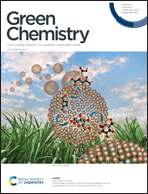Rapid exfoliation for few-layer enriched black phosphorus dispersion via a superhydrophobic silicon-nanowire-embedded microfluidic process†
Abstract
The exfoliation of bulk black phosphorus (BP) into few-layer BP flakes is a critical process for wide applications of atomically thin layered BP. Although liquid exfoliation enables scalable and facile production of few-layer BP flakes, the low exfoliation efficiency remains a major hurdle, and thus, an advanced exfoliation technique is needed. In this study, we introduce a novel exfoliation technique via a superhydrophobic silicon nanowire (SiNW) microfluidic system under ultrasonic treatment, and this is designed to significantly promote the cavitation effect. The promotion of the cavitation effect enables rapid fragmentation of bulk BP, and the delamination of the fragmented BP subsequently occurs at a considerably lower cavitation effect. The strategic separation between the fragmentation and the delamination under the controlled cavitation effect leads to rapid production of few-layer enriched BP flakes with high uniformity in an aqueous medium. The results substantiate the potential of a superhydrophobic SiNW microfluidic system for the clean and highly efficient production of thin-layered 2D materials.



 Please wait while we load your content...
Please wait while we load your content...